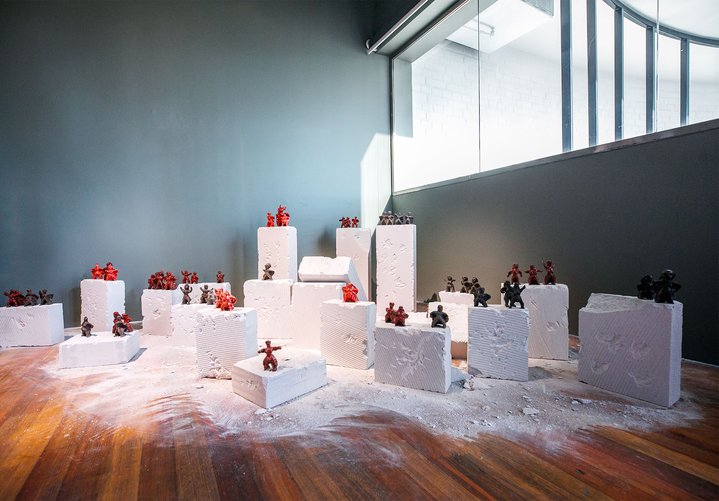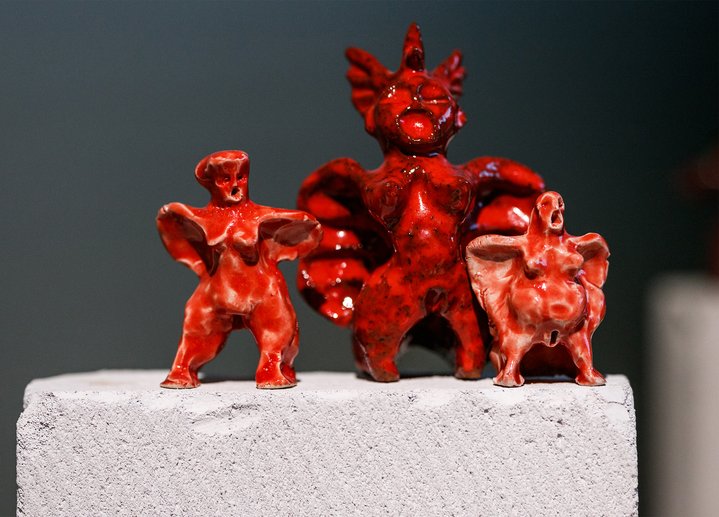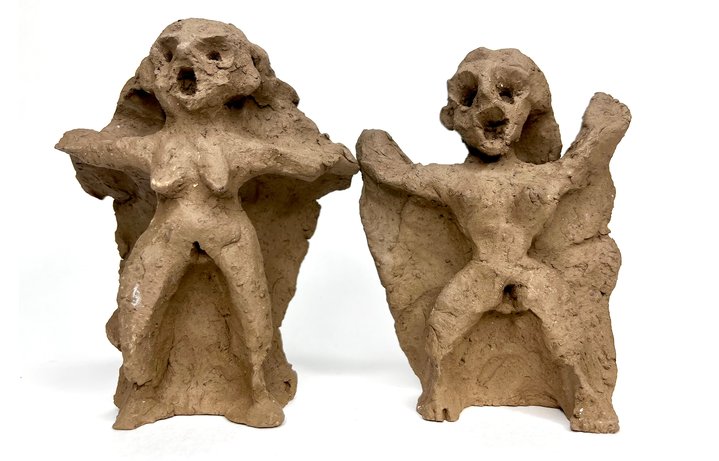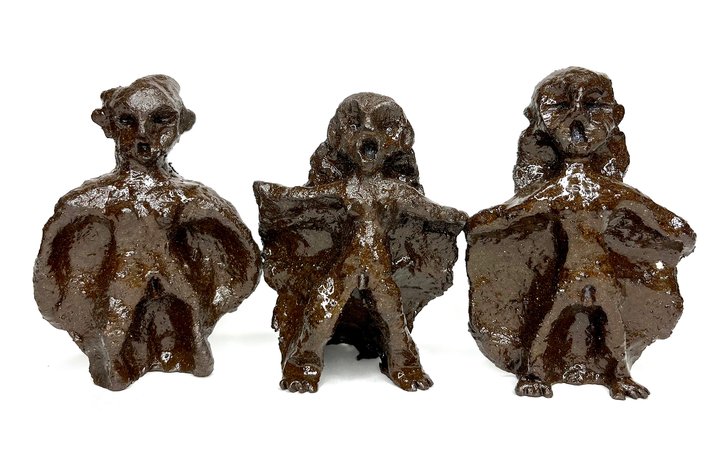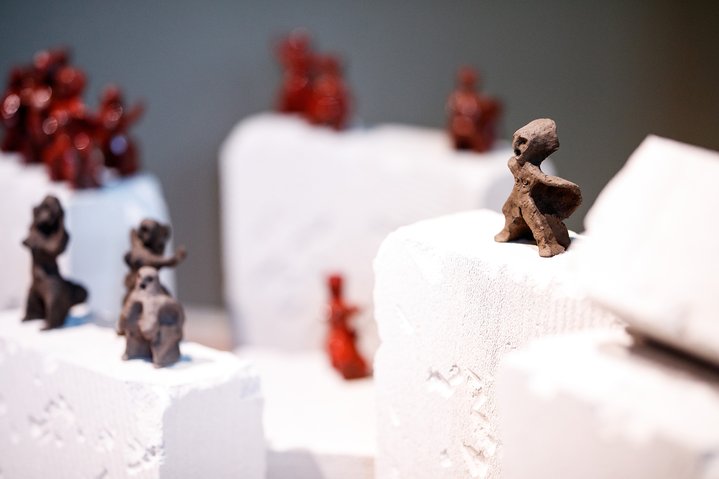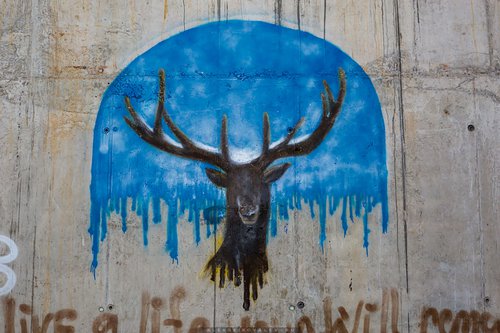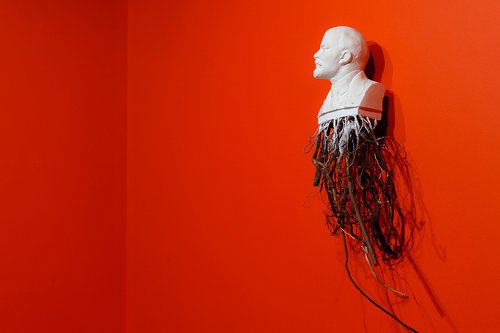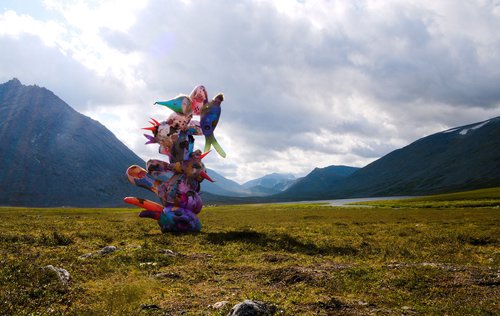Mayana Nasybullova. War. Mixed media. 2022
Mayana Nasybullova: on Lenin, trauma and paradise
An artist from Siberia has unveiled a powerful exhibition on catastrophe, trauma and healing in Moscow. The project bears a timely name: Everything Is Terrible.
It is no secret that Russia is a vertically organised country, yet its talent is scattered across vast expanses. However, if you were born in a small town in Siberia, getting to Moscow and becoming an artist there is not so easy. It requires a strong temperament, an iron will with a dash of workaholism. But Mayana Nasybullova (b. 1989) has done just that. Today she lives and works between Novosibirsk, Moscow and St Petersburg.
Nasybullova was born in the town of Serov in the Sverdlovsk region. It is a very small town, but an important stop on the Transsiberian railway. Her father was a Ural Tatar, which explains her unusual name. However, early on the young family moved to Barnaul, an old Russian industrial town in the Altai region. From Barnaul, Mayana went to study in Novosibirsk, the largest city in Asian Russia. It sounds easy on paper, but the distance from Serov to Novosibirsk is almost two thousand kilometres, and from Novosibirsk to Moscow another three and a half thousand. Such are the distances in Russia. ‘It seems to me that I was engaged in art all my life, and as soon as I got a pencil in my hands I immediately began to draw. And right away it became clear to everyone what I was going to do in life’. To study art in Barnaul meant to study decorative and applied art so in her arsenal the young Nasybullova acquired the professional skills to work with paintings, ceramics, jewelry and many other applied techniques, which later determined her own artistic style. ‘The academy in Novosibirsk was a dream, and the city itself was huge, with a vibrant student life. I studied monumental and decorative art, but the education system itself seemed very oppressive and uncreative to me. I was lucky enough to meet very different people who were always thinking what contemporary art was all about and they gave me a new perspective. My first solo exhibition was called ‘Awakened Plaster’, and using my camera and pencil I explored plaster casts of classical statues at the Academy, the same ones that had seduced me into going there in the first place. Apparently, this was my goodbye to the Academy, as I realised that I had already moved on to contemporary art.’
Nasybullova was born in 1989 and completely missed out on the Soviet period. She was never a member of a children's Communist organization, such as Oktyabriata and the Young Pioneers, and at school she did not learn about Lenin or the Communist Party. But questions about historical memory are central to her work. In addition, there were (and still are) many artefacts left over from seventy years of Soviet history. In Novosibirsk, for example, there were ten monuments to Lenin! The mayor of the city was a member of the renewed Communist Party and many people did not want to forget their youth and the past. ‘Very often older people who remember the Soviet Union ask me questions. They wonder why I refer to the past in my projects. And I reply that history cannot be appropriated, no one has a monopoly on history, history is something we have in common. I believe that after the documents were formally signed, the Soviet Union did not come to an end. Its legacy and its world view proved to be very endurable. This legacy was passed on to me as an oral family history. And I always felt that this is part of my life, too.” In Novosibirsk, Nasybullova rented a flat that was full of Soviet era relics which had once belonged to friends of her grandparents, the previous owners. When consumer goods had been scarce and difficult to obtain in USSR from the 1960s onwards, her friend’s grandparents had been hoarding what they believed to be valuable at time. Nasybullova now finds a kind of reverence towards these things, she loves looking at them and giving them a new life. This is the inspiration behind her project ‘Actual Amber’, where Soviet era relics were embedded in ‘amber’ polyester transparent resin, like a prehistoric mosquito from the Kaliningrad Amber Museum. Her past experience in making jewellery can also be seen in this project, in which the past is turned into a conventional 'jewel'.
With her interest in Soviet Russian history, it became tempting to deconstruct Lenin’s character itself, which was the impetus behind Nasybullova’s project called “Lenin for the Soul’. It involved the reproduction of ironic internet memes. According to Karl Marx's famous phrase, ‘History repeats itself first as a tragedy and then as a comedy and mankind, laughing, abandons its past’. In Russia, long ago Lenin stopped being a historical character, and he became a symbol or a persistent ghost. His image was one of the most proliferated, like Jesus and Che Guevara. Of course Lenin died long ago, but as a symbol he is preserved in the Mausoleum, at the heart of Moscow's Red Square. ‘I thought it was funny. I started making little figurines that deliberately imitated Russian tourist souvenirs with a crazy mix of famous heroes taken from different historical eras: Peter the Great, Nicholas II, Lenin, Stalin and Putin. These sculptures became popular and everyone asked me about them and then I decided to look into why. Then, I began to select images of deities or teachers of life or even Hollywood movie characters and I put Lenin's face on them. And it turned out that it matched this pantheon perfectly! The souvenir shop in general explains a lot. Wherever you go, you see that a variety of saints and heroes of the past are all sitting together on the same shelf. All the most sacred things for which people were ready to kill and die become replicated tourist souvenirs’.
Following wider trends in the global art world, at some point major Russian art institutions also became interested not only in just Moscow, but in what was happening throughout the vast expanses of Russia. In 2017, the Garage Museum of Contemporary Art initiated a programme aimed at developing and promoting contemporary art in Russia. Over several months, curators from the Garage travelled all over the country, viewing the work of two hundred artists and chose seventy of them for an exhibition in Moscow. “In 2017, I got to the Garage Triennale and a completely different world opened up to me. I saw with my own eyes what contemporary art is and how modern museums are organised. All the artists were put up in the luxurious Marriott hotel and they showed that bourgeois place what real rock'n'roll is with its loud parties (after that artists were not accommodated in the Marriott again). And, of course, I wanted to move to Moscow right away. But I didn't move there until 2019 through a ‘workshops for artists’ project.’
Nasybullova’s new project, ‘Everything Is Terrible’, curated by art historian Olga Turchina, was opened at the Vadim Sidur Museum in Moscow last month. The exhibition begins with a quote by French engineer and philosopher Jean-Pierre Dupuy, who studies disaster theory: “Many years have passed and it's as if we have not understood anything about the essence of evil.” Vadim Sidur (1924–1986) is an artist who has an unusual destiny, who experienced the Second World War and, in defiance of the Soviet system, became a modernist sculptor. There is a strong anti-war pathos concealed in his works (his ‘Monument to the Perished by Violence’, was erected in the German town of Kassel in front of the Fridericianum, the central building of the international contemporary art forum Documenta). And this dramatic story of war and personal destiny was read by Mayana Nasybullova in our own, historical time.
How do you make exhibitions when you know what is happening very close by, where bombs and missiles fall and people die? The project brings together an image of civilization’s catastrophe and personal trauma. The body with its imperfections, the body's powerlessness against the tearing steel and Molech of history, heroism and resistance. Nasybullova unites contrasting textures and different found objects. Ceramic pieces, which are often still seen as arts and crafts, suddenly become sculptures, because the traces of fingers tearing into the clay remain imprinted in the body of the clay figures and show how every ill-conceived gesture can lead to a disaster that can distort, alter and destroy a fragile life. But then you reach the next room, where an image emerges of an unattainable paradise, a garden of Eden. However, there is no way out of this paradise. All you can do is walk down a precarious path made of planks to return to the space of unfolding disaster which never ends. And only white flags made of gauze, medical bandages displayed outside suggest a place of trauma and healing. ‘As an artist I am able to tell a story and that story you can only hear from me. This approach has become key for me.’
Mayana Nasybullova. Everything is Terrible
Vadim Sidur Museum, branch of Moscow Museum of Modern Art
Moscow, Russia
June 9 – August 7, 2021






